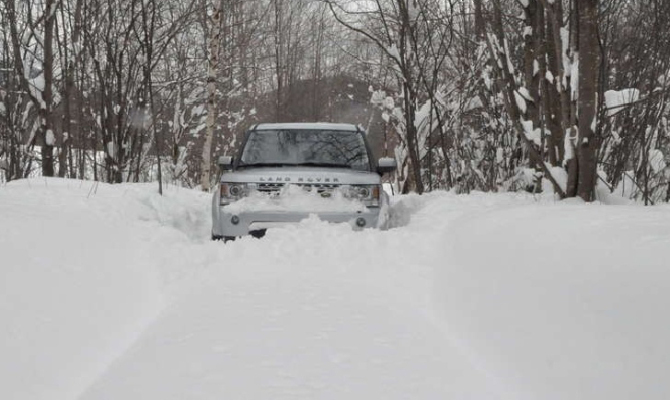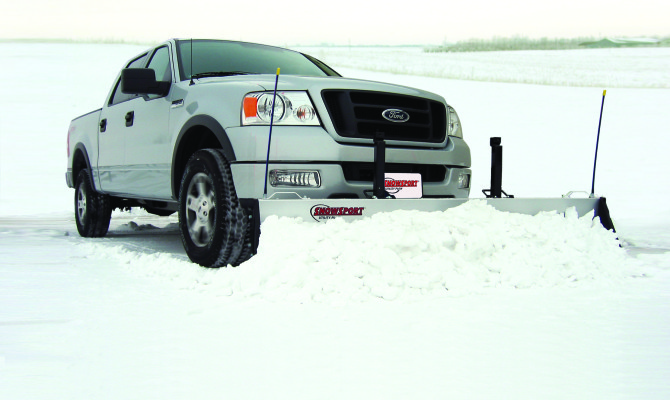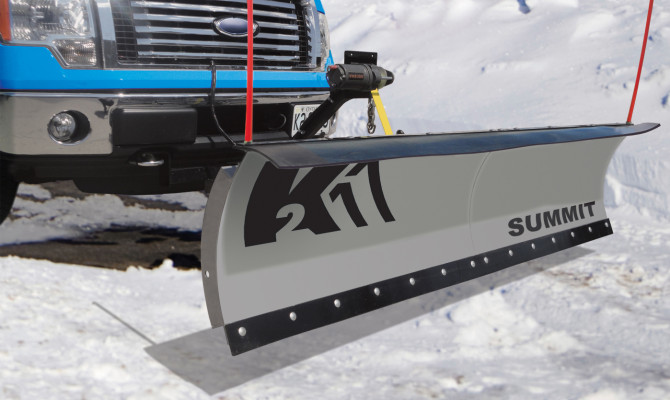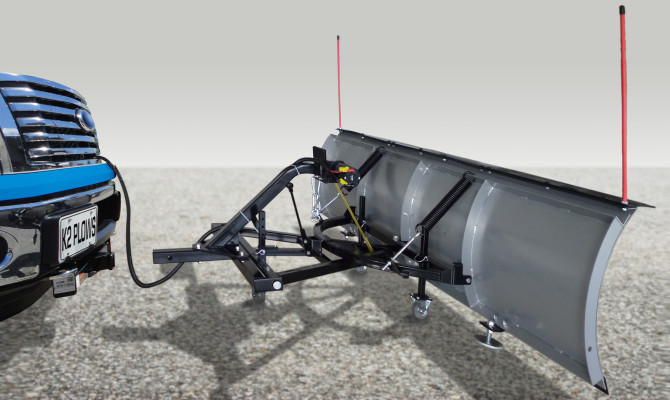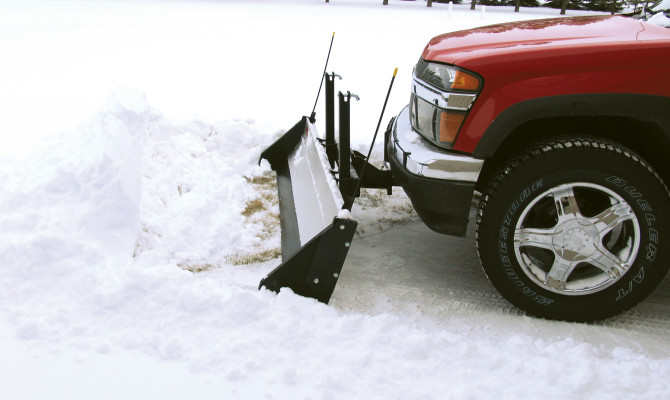 When the snow falls, watch out for drivers who couldn’t be bothered to sweep the white stuff from the roof of their car before setting out in the morning.
When the snow falls, watch out for drivers who couldn’t be bothered to sweep the white stuff from the roof of their car before setting out in the morning.
They are a danger to themselves and other road users. When the car heats up that snow generally slides down in a block over their windshield causing one-car white out conditions, long enough for them to collide with you!
What drives-u-crazy?
“Actions by cars and trucks will alert you more quickly to problems and give you a split second extra time to react safely.”
The rain and windstorms have started and it won’t be long before the temperatures start to dip. Northern B.C. and the Interior have already experienced the cold.
At the coast, it seems every year the first snowfall creates chaos and adjusting to the conditions is a big challenge for many people. That said; driving in the winter season generally presents more problems than driving in other seasons wherever you call home. The vehicle and the driver must be prepared as well as possible to cope with these kinds of driving conditions.
In winter driving, braking and stopping the vehicle, of course, cause the most difficult moments. The tires play a critical role in stopping the vehicle, and they need even more care and attention than in the other seasons.
Most SUVs have a passenger car tire classification with M+S stamped on the sidewall, for Mud and Snow and are considered all-season tires. If it is not, your vehicle must be fitted with tires suitable for any type of climate, even the most severe ones.
In winter the pressure of the tire must also be controlled more frequently. This is because a reduction of the outside temperature causes a contraction of the air inside the tire, accelerating the normal and gradual pressure loss process by a value around 1-2 PSI for each 5° C decrease in temperature.
Contrary to popular opinion, a lower inflation pressure than normal does not improve tire traction on snow. It makes them much more liable to damage. Always remember that in any season and with any temperature, insufficient pressure is always the main cause of tire damage. Here is some advice to always bear in mind it is during winter driving conditions: Use brakes carefully. Brake early. Brake correctly. It takes more time and distance to stop in icy conditions. Watch for slippery bridge decks, even when the rest of the pavement is in good condition. Bridge decks will ice up sooner than the pavement. Do not use the cruise control in winter conditions. Even roads that appear clear can have sudden slippery spots and the short touch of your brakes to deactivate the cruise control feature can cause you to lose control of your vehicle. Don’t get overconfident in your 4×4 vehicle. Remember that your four-wheel drive vehicle may help you get going quicker than other vehicles but it won’t help you stop any faster.
Many 4×4 vehicles are heavier than passenger vehicles and actually may take longer to stop. Don’t get overconfident in your 4×4 vehicle’s traction. Your 4×4 can lose traction as quickly as a two-wheel drive vehicle.
If your vehicle is equipped with anti-lock brakes, do not pump them in attempting to stop. The right way is to step on the brake pedal and steer against the slide. Look further ahead in traffic than you normally do. Actions by cars and trucks will alert you more quickly to problems and give you a split second extra time to react safely.
Learning car control in less than perfect circumstances is available to all who have $795 . . . it’s money extremely well spent…
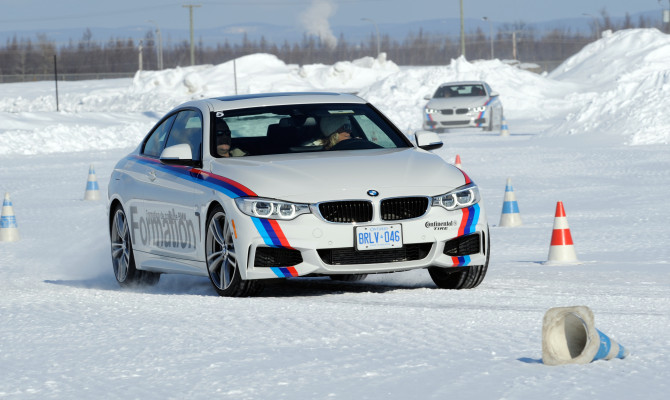
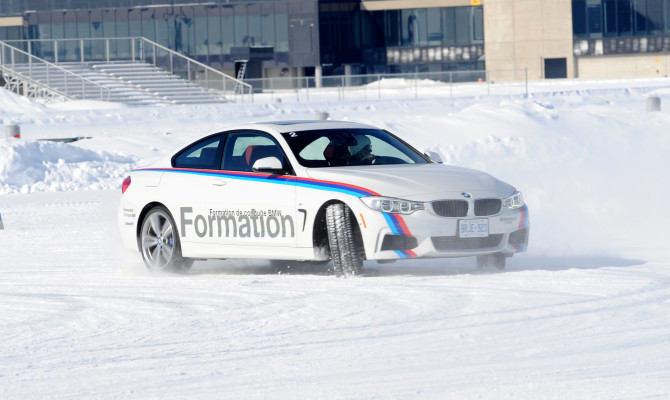
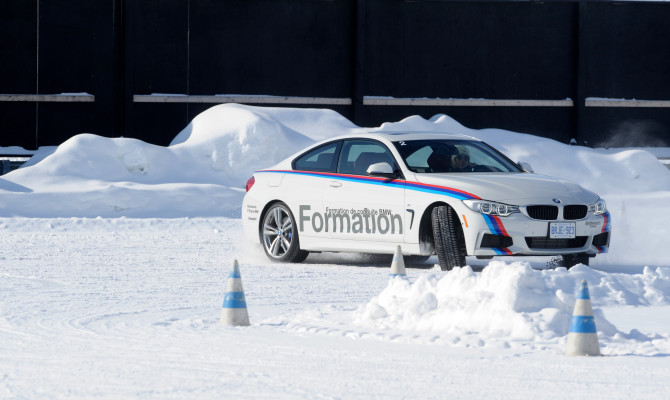
The man from BMW once called me a hooker.
Surprisingly, I wasn’t that offended. I actually laughed at such a descriptor, as did everyone else around me.
I didn’t feel so bad because I wasn’t the only one in the group labelled thusly at the brand’s Driver Training; a full day of driving 3 Series sedans (back then) to improve our own car control. I didn’t have too many years of driving experience back then but I unfortunately had picked up a few bad habits on the road.
What’s a hooker, according to the instructors at the German automaker’s training?
Someone who hooks his or her hand into the steering wheel when making a turn. It’s a big boo-boo and not an effective way to drive. It’s also totally unsafe, should an accident occur in the process. Needless to say, pointing out the hooker in me caused me to change my habits for the better.
And in the most recent installment of learning car control with BMW, no such noun was used when relating to my technique. Thank goodness.
It’s minus 15 degrees at the ICAR track in Mirabel, Quebec. The sun is out and there’s a lineup of all-new 435i coupes just begging to be driven.
Some are equipped with the brand’s all-wheel drive system. Some are rear-wheel drive. Regardless, I’ll have my way with both configurations by the end of the day, so to speak.
The adventure is better known as the Winter Driver Training program, offered exclusively at the ICAR location. That said, you don’t need to own a BMW to participate. Learning car control in less than perfect circumstances is available to all who have $795. In my opinion, it’s money extremely well spent.
The day starts out with an in-class session that goes over theory and what will be executed throughout the various exercises. It’s kept relatively short so we have more drive time.
It’s mentioned that we’ll be practicing manouevres with and without electronic help, to put both power and performance to the test. Oh yeah.
Proper seating position is outlined when we initially get behind the wheel. Then we’re off.
You might ask what is the point behind putting one of BMW’s latest products sideways on an ice track in subzero temperatures. My initial answer is only three letters long and to the point: fun. But that’s only a byproduct of what the impetus behind the program is; a program that started back in 1977 and is now offered in 35 countries.
The main goal is safety. It’s designed to introduce drivers to techniques that might help correct the car if it is not doing what you want it to for whatever reason.
For example, if your wheels are pointed in one direction, but your car is going straight ahead, what should you do? That’s called understeer. The instinctual thing to do is keep adding more steering, but that won’t help. Ease off the throttle and try to straighten your wheel so your tires can regain grip.
Or, if you feel the back end of the car breaking loose, how do you wrangle it in? You countersteer and don’t lift off the throttle. It sounds easier said than done, but the techniques do work!
Putting yourself and the 435i through the paces in a safe and controlled environment is the best place to learn. If you spin out, you’re not going to go into oncoming traffic. You just stop, turn the car around, and keep going. You’ll probably giggle a little in the process and tell yourself you’ll “get it next time.”
Heck, if you knock over a few cones, no one will judge you either. It’s all part of the process.
There are also dynamic braking exercises that teach you how the car reacts when you have ABS, and what you can do in these conditions. You’ll even learn reverse 180s.
Philippe Létourneau is the head instructor of the program and says, “People learn a lot more when they’re having fun.”
I agree.
He also mentions that if people walk away from the course with a couple of newly established driving habits that make them overall a safe driver, that’s ideal.
However, if your face doesn’t feel stiff from smiling, or your abs don’t hurt from laughing, perhaps you weren’t trying hard enough. What’s not to like about that?
Even if you mess up, you keep going… it’s part of the learning experience… (more…)
If you’re travelling across our province to spend time with family this holiday season, be realistic about travel times and check out the road conditions via DriveBC.ca ahead of time so you can prepare yourself and your vehicle for any challenging weather you may encounter.
People get killed because they undertake horrendously long road trips over strange terrain…
Many Driveway readers will hit the road soon to visit distant friends and loved ones to celebrate Christmas and the New Year.
But before you fire up the engine, please ponder the following thoughts, because our Driveway crew wants you back home safe and sound at the end of this joyous season!
. . .
You promised your distant family you would get there in time for dinner if it kills you.
Unfortunately, that’s exactly what happens at this time of year: people get killed because they undertake horrendously long road trips over strange terrain.
Resist the urge to tell your family exactly when you expect to arrive. Tell them to go ahead and eat, you’ll get something along the way.
What occurs too often is you end up setting yourself an unrealistic time to get there in your enthusiasm to re-unite with loved ones. You figure out the distance and divide it by the posted speed limit. Forget that; you’ll be lucky if you get near the posted limit in winter conditions.
How do you figure how long it’s going to take to get to Aunt Maud’s this year? Well, recall how long it took last June then add about 15 minutes for every hour… to allow for inclement weather.
In addition, if really bad weather is forecast, you don’t add anything you just postpone the trip for 24 hours or longer.
Also, if your most optimistic travel time estimate tops three hours don’t head out after work but wait until daybreak the next day. It’s not ideal out there at this time of year and you don’t want to travel through unfamiliar territory in darkness.
Once you have set out, stop for a few minutes every hour along the way, walk around the car and draw a few deep breaths. Stop for coffee or take a Thermos if there’s no place to stop along the way.
Share the driving but if you’re alone and get drowsy pull off for a nap or better still check into a motel. Aunt Maud would prefer you to arrive alive tomorrow than have you arrive dead on time tonight.
A list for travellers… don’t leave home without it.
- Road maps for finding your way if you don’t have satellite navigation.
- A scraper and a brush to rid your windshield of ice.
- A shovel to dig the snow from around the tires and a piece of carpet to use as a traction pad.
- A first aid kit, a flashlight, matches and a candle to help you find where you stowed the first aid kit.
- Some extra fuses, belts and hoses, tools, road flares and reflectors.
- A Thermos of hot tea or coffee and some choc bars for energy.
- Warm clothes within easy reach and blankets in case you get stranded.
Driving can be challenging no matter where you live in the province at this time of the year. (more…)
For most people who are just using a plow for clearing their own driveway, a straight-blade will more than likely be just fine…
I know I wrote about winter driving last week – and the snow and rain began to fall in various parts of the province – but please don’t blame me for this first blast of chilly weather.
I’m here to help and at the risk of bringing on a blizzard, I thought I would share some information on snow plows.
For most people who are just using a plow for clearing their own driveway, a straight-blade will more than likely be just fine. Snowsport offers a personal plow that is perfect for the homeowner. This system attaches to a front mounted receiver just as a boat trailer would.
The U shaped bracket is connected to the receiver and the snow blade rides up and down on these bars to allow for change in the terrain your plowing. Because there are no hydraulics involved, all you do is back up and the snow blade lies back skimming over the surface.
When driving forward the blade automatically re-engages for plowing. When you are finished, lift the blade back over the push frame into the transport position. The cost of this option is $1,644.
K2 is another brand of snowplow designed for the homeowner with acreage. Designed to work with a front receiver hitch, just like the Snowsport, it simply slides in the receiver and locks in place with a hitch lock. The winch is controlled from inside the cab and will raise or lower the height of the blade. The blade comes with a hardened steel cutting edge scraper, rubber snow deflector, skid shoes, and plow markers. It is available in 82”, 84”, and 88” lengths. Cost is $1,315.
If you use a plow to make money, then you will want to be able to do the job quickly and efficiently, so you may want to go with the multi-position. Multi-position plows are up to 50 percent faster due to the fact that you can reposition the blades to all straight-blade positions in addition to the scoop and V positions. This makes the plow adaptable to nearly any job you need to do.
When it comes to the composition of the blade you have the choice between steel and poly. The vast majority of snowplows on the market today come with steel blades, although the poly plows are becoming more and more popular.
The reason for the growing popularity is that poly is just as strong as steel and maybe stronger. They also have a lower coefficient of friction, which saves on fuel costs and is easier on your vehicle. The poly plows are also saturated with color all the way through so nicks and scratches do not show like they do with steel, plus they do not rust.
Attaching and detaching the plow is very important as well. You do not want to be freezing and trying to deal with getting a blade on and off your truck. Try the attachment system for yourself at the dealer so you can see firsthand how easy or difficult it is to use.
Most snowplow makers use a single halogen light bulb, which are not bright enough; some makers have come out with dual halogen bulbs with the option of upgrading to High Intensity Discharge. These HID lights are four times brighter than standard halogen bulbs and also last ten times as long.
Hydraulics is probably the most important part of the plow, along with the controls. Be sure that the hydraulics system is dependable and the controls are simple and easy to use. Go for quality rather than trying to save a buck. Remember “you get what you pay for” definitely applies here. Cost for these units are $6,000 to $8,000 depending on the model.
When it comes to the warranty, be sure to know exactly what you are getting and what the warranty covers. Some only cover parts, while others cover parts and labor. Warranties are usually either one year or two years; so pay attention to the warranty.
Take all of these things into consideration when shopping for a snowplow and you will be able to choose the right one to suit your needs.
Contact:
Ice and snow can hit unexpectedly at this time of the year.
This is a good time to make sure your tires are rated for the conditions you may be driving in and check your tire pressure regularly – pressure drops in cold weather and overinflated tires can reduce gripping.
Remember that your four-wheel drive vehicle may help you get going quicker than other vehicles but it won’t help you stop any faster…
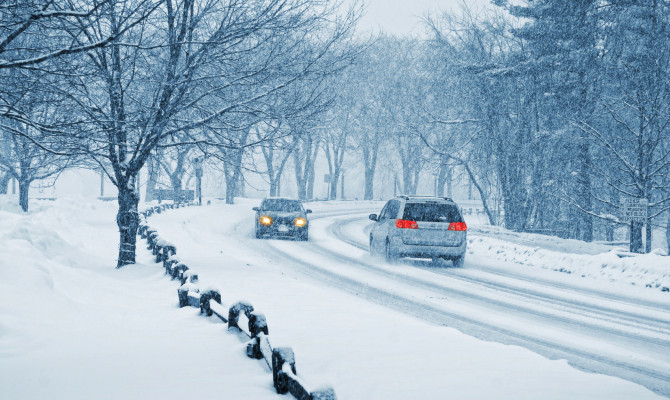

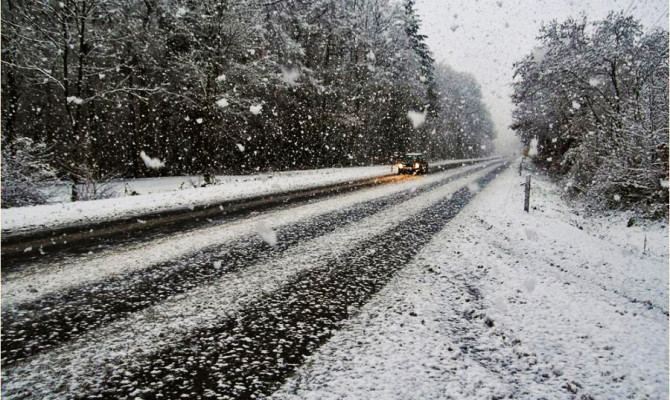
The temperature is starting to drop, the leaves are clogging up the streets and snow is beginning to fall in parts of B.C. (more…)
Recent Comments
- { Enjoyed your Forest of Bowland in the BMW X5M, particularly the photo of the BMW in front of the main part of Stonyhurst College where... }
- { Bantam designed the Jeep, not Willy's or Ford. The American military gave the original Bantam prototype to Willys and Ford to copy. There is plenty... }
- { All Escalades come with a 6.2-lilter V8 engine that produces 420 horsepower. A six-speed automatic is the only transmission offered and drives the rear wheels.... }
- { Alexandra is an excellent journalist. }
Popular Posts
- Journey to a ‘Sparkling’ Luxury Okanagan Resort “Four lucky readers will put a Dodge Journey’s weekend-...
- The Need For Speed: Hike Those Highway Limits More than half of those polled believe the province sho...
- Drives-U-Crazy… Erratic drivers. An early morning drive from Kelowna to Vancouver is nor...
- Readers Respond: The Pros and Cons of Increasing B.C. Speed Limits Increasing the speed limits will only increase risk to...
- Honda CR-V Review: The Compact Crossover To Get Things Done The CRV is a very stylish and aerodynamic crossover veh...


